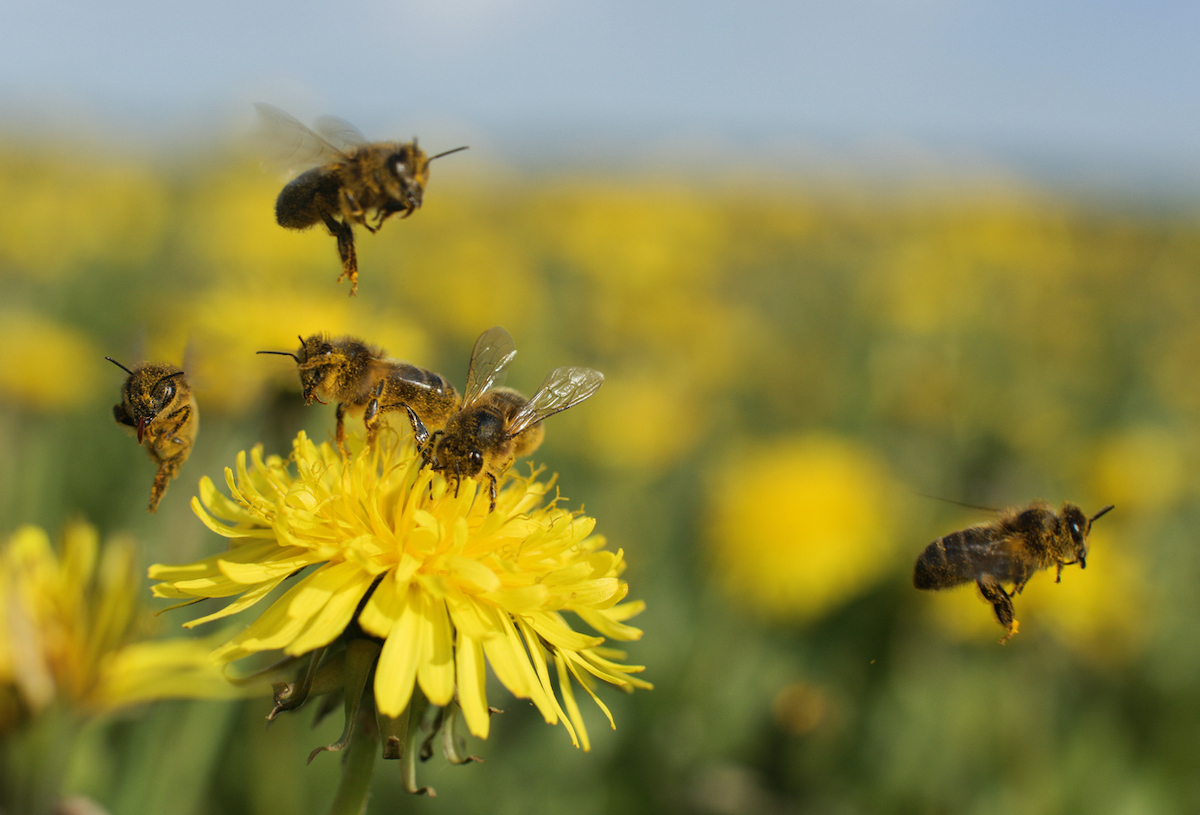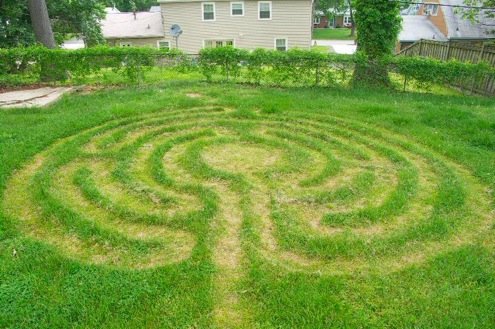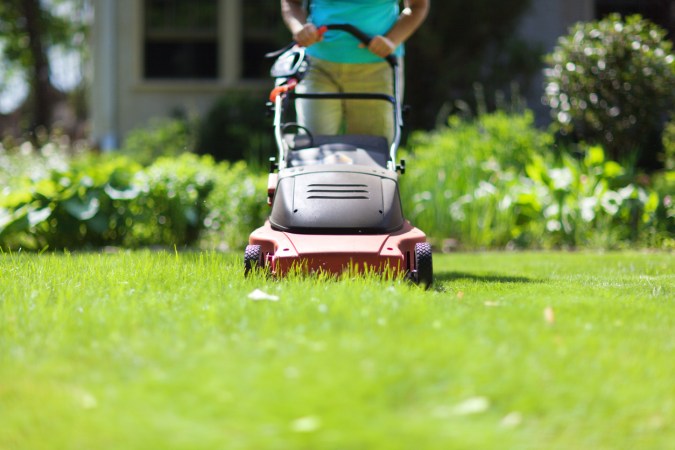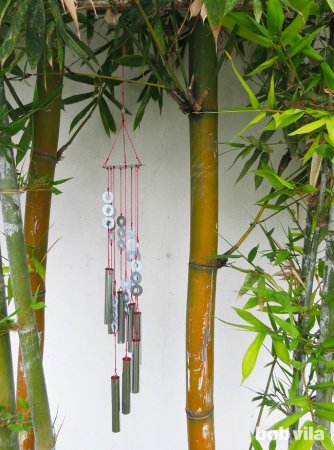We may earn revenue from the products available on this page and participate in affiliate programs. Learn More ›
You might be surprised to learn there are more than 20,000 types of bees in existence, and a whopping 4,000 of those call the U.S. home, according to the U.S. Geological Survey. Bees are a lifeline for plants that require pollination to produce fruits, flowers, and vegetables. While other insects also contribute to pollination, bees are the primary pollinators, and crop growers rely on them for good harvests. Though many types of bees are similar in size and coloring, others are quite different—not only in appearance but in behavior. Ahead, learn about the following 10 types of bees, and find out how to identify them in the garden.
RELATED: 10 Flowers That Attract Bees to Your Garden
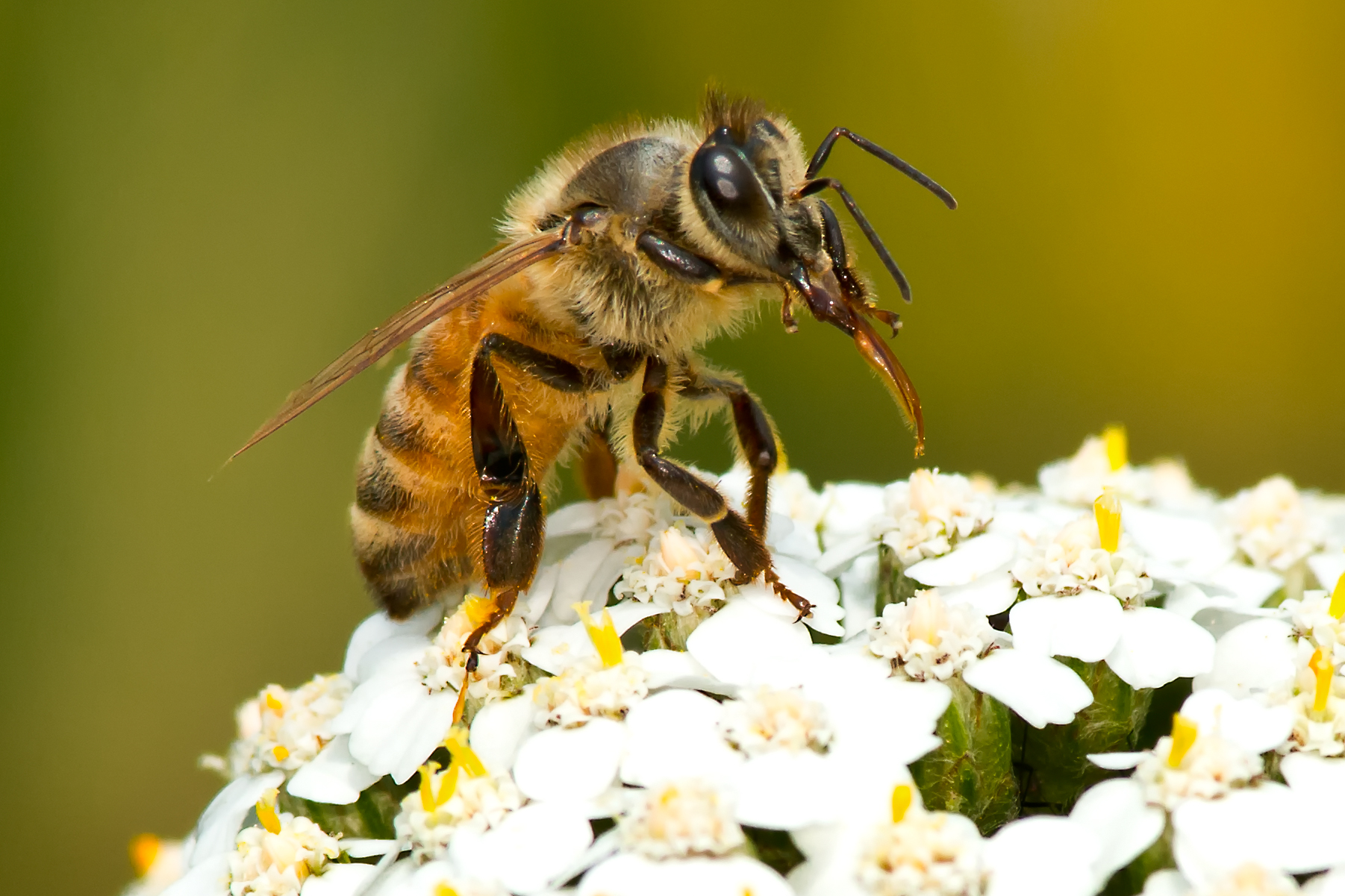
1. Western Honeybee
When most think of honeybees, they’re picturing this fellow, also called the “European Honeybee.” Beekeepers raise the western honeybee (Apis mellifera) for its honey, bee pollen, and other bee-related products. Bearing recognizable brown stripes on a mustard yellow body, the western bee is prized not just for honey production but for its ability to pollinate crops, which increases harvests. The western honeybee encompasses at least 20 subspecies throughout the world, some occurring naturally and others resulting from species blending by beekeepers. These honeybees congregate in colonies that have a single queen bee. The eggs are haplodiploid, meaning they can become either female or male—unfertilized eggs become male drones, while fertilized eggs become female worker bees. The queen bee, chosen at the larval stage and fed a diet of royal jelly and nectar, is the only female that lays eggs. The other females are nonreproductive and become worker bees. Only worker bees can sting, but they don’t set out to do so—they only sting to protect the hive. After the worker bee stings, its barbed stinger remains in the victim, and the bee dies.
Key Characteristics: Western honeybees are ⅓ inch to ½ inch long, brown and yellow striped, and find brightly colored blossoms most attractive. This bee carries pollen on its legs, appearing as large yellow or orangish clumps when it’s gathered as much as it can hold.
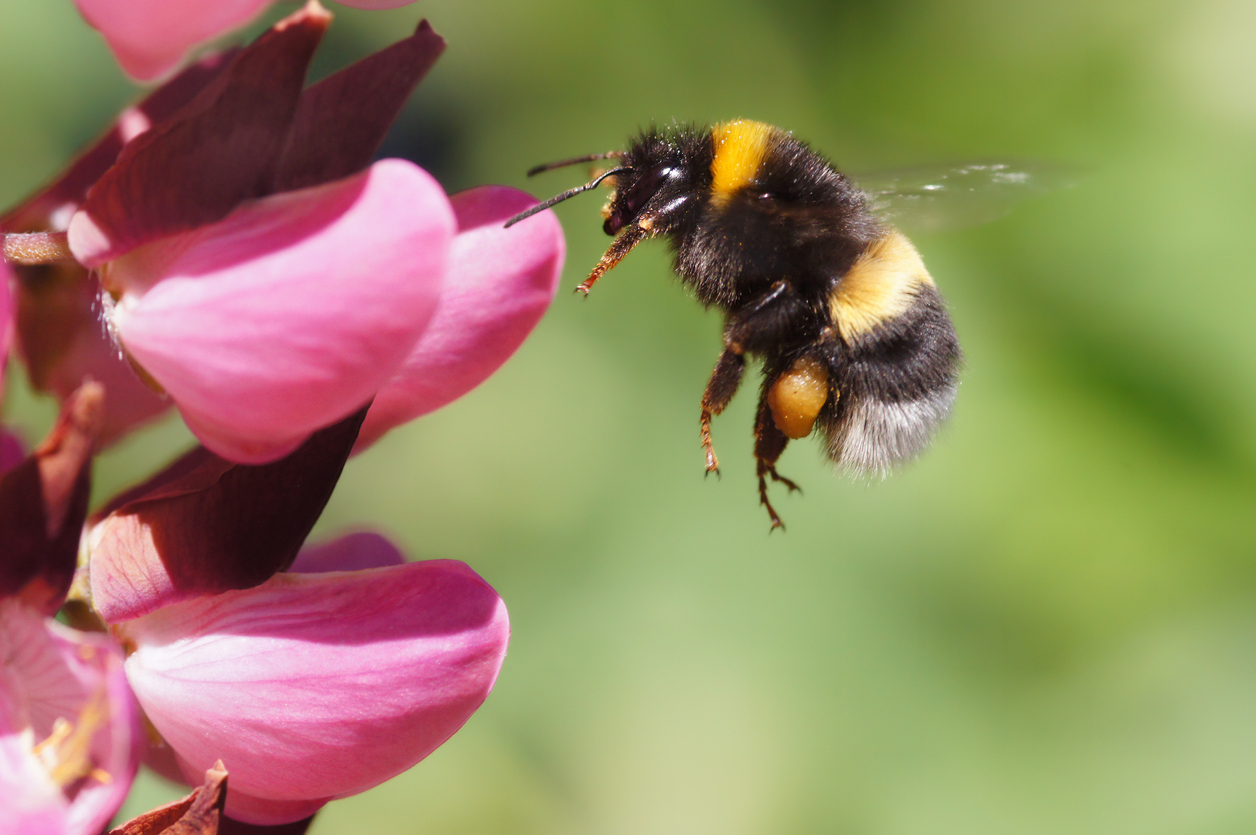
2. Bumblebee
Larger than honeybees, the bumblebee (Bombus dahlbomii) ranges in size from about ½ inch to 1 inch in length, although with more than 255 species of bumblebees, some species are notably smaller. It features a fuzzy rotund body with dark brown or black combined with bright yellow or orange stripes. Bumblebees are found worldwide and typically build their nests near the ground, in abandoned rodent tunnels, in the foundations of structures, or even in piles of dead limbs. Bumblebees are social by nature and live in colonies ranging from 50 to 500 members. Like honeybees, bumblebees choose a queen who rules the colony. Only the queen lays eggs, and the other bumblebees collect pollen and nectar from blooms to feed themselves and the queen. Unlike on honeybees, the stinger on a bumblebee is smooth, so it doesn’t pull off when the bee stings, and the bee can sting multiple times.
Key Characteristics: Bumblebees have large, round bodies with dark brown or black stripes interspersed with bright yellow or orange coloring. They appear fuzzy and emit a loud buzz that people can hear from a distance. They seek out colorful blooms to pollinate and to collect pollen and nectar.
RELATED: How to Keep Bees in Your Own Backyard
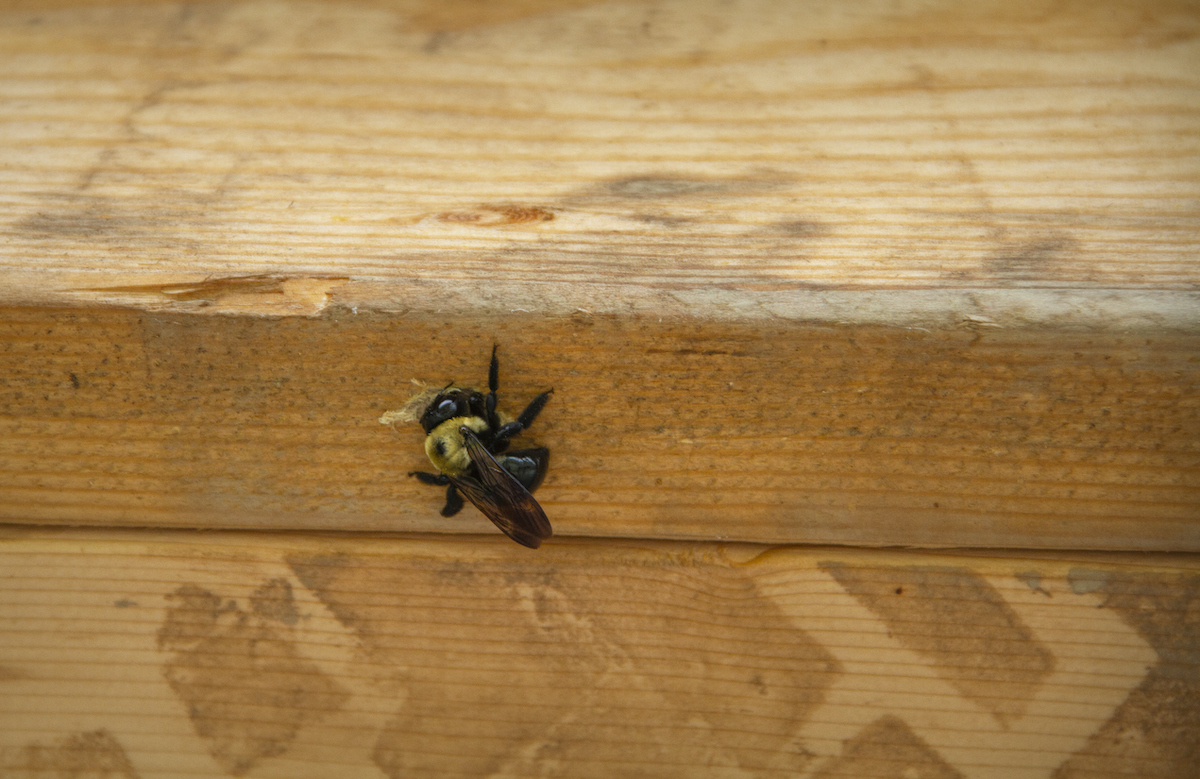
3. Carpenter Bee
Sometimes mistaken for bumblebees, carpenter bees (Xylocopa spp.) range in size from about ½ inch to nearly an inch long and are black and yellow. The difference, however, is that carpenter bees have a black tail end and a yellow upper body rather than stripes. While valued for their ability to pollinate plants, which makes them beneficial to home gardeners and growers, carpenter bees also have a shady reputation. Carpenter bees nest in wood, drilling holes and creating tunnels in dead trees, wood fences, decks, and even the wood structural parts used to build homes. At first glance, the tunnels they drill might look relatively shallow, only an inch or two deep. In reality, the tunnels can be up to 10 feet long. Both male and female carpenter bees drill tunnels for nests, but only the female bee will sting. Instead, male carpenter bees exhibit aggressive, dive-bombing behavior to keep predators away from their nests.
Key Characteristics: Approximately ½ inch to just under 1 inch in length, carpenter bees have a black tail end and a yellow upper body. They drill long tunnels in wood to create nests.
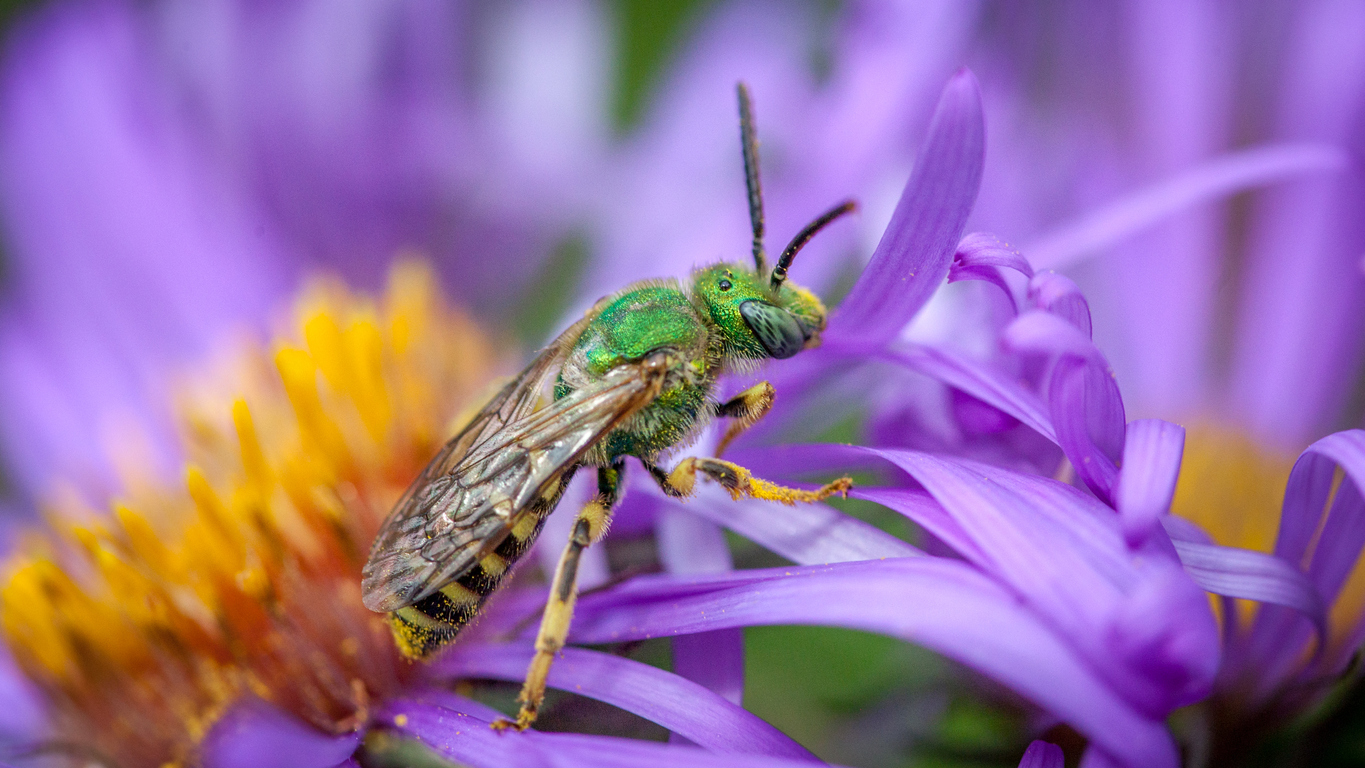
4. Sweat Bee
Named because of their attraction to perspiration, the sweat bee (Halictidae) is a small bee that bears colorful metallic shades of green and blue, although some in this species of more than 500 are brown and black. Some sweat bees feature bands of color, and all are valued for their contribution to pollinating plants. Adults range from ¼ to ¾ inches long, with most species at the smaller end of the scale. Sweat bees live in all countries, but they tend to like temperate regions the best. They nest underground in colonies and gather pollen and nectar to feed the colony and themselves. Only female sweat bees sting, and when they do sting, they continue to pump venom into their victims until they’re removed. To minimize the pain of a sweat bee bite, brush the bee off as soon as it stings.
Key Characteristics: With more than 500 species and multiple colors, sweat bees can be difficult to identify, although many have a metallic sheen and are relatively small. They’re also attracted to perspiration.
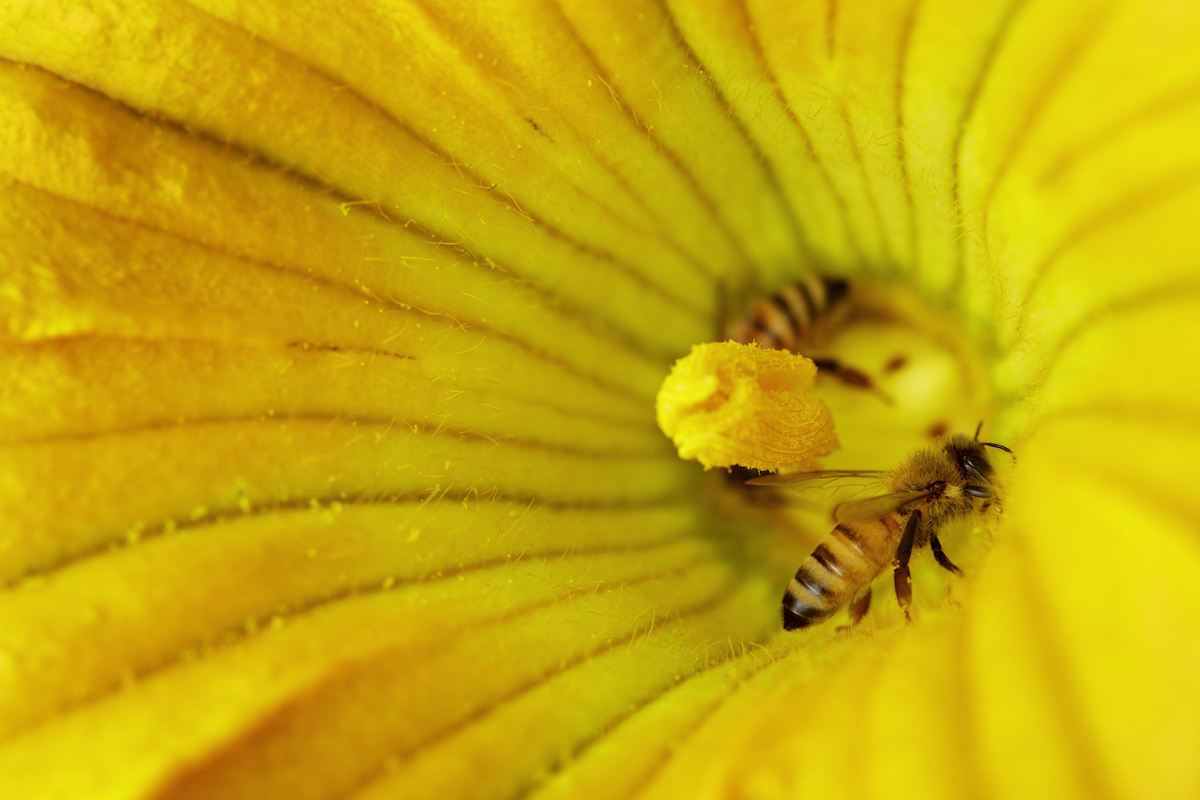
5. Squash Bee
For growers of certain types of vining vegetables, the squash bee (Peponapis pruinosa) is a welcome sight. This beneficial bee is an early riser and can be found hard at work just after dawn. The squash bee primarily pollinates the blossoms of vegetables in the Cucurbita family of plants, including squash, pumpkins, and gourd varieties. All 13 species of squash bees resemble honeybees with gold and black coloring, but they are usually slightly larger, and the female squash bee has fuzzy hind legs, while the honeybee has smooth legs. The squash bee’s face is also rounder, but these differences are so slight, most mistake the squash bee for a honeybee. Squash bees nest in colonies below ground, often near the plants they’re pollinating. While honeybees will also pollinate squash plants, squash bees will not pollinate plants of other species. Rather than a queen bee, every female squash bee has her own nest and lays eggs. Only the female bee stings, and only if provoked.
Key Characteristics: Squash bees closely resemble honeybees in shape and coloring, but the female has fuzzy back legs while a honeybee does not, and these bees nest below ground.
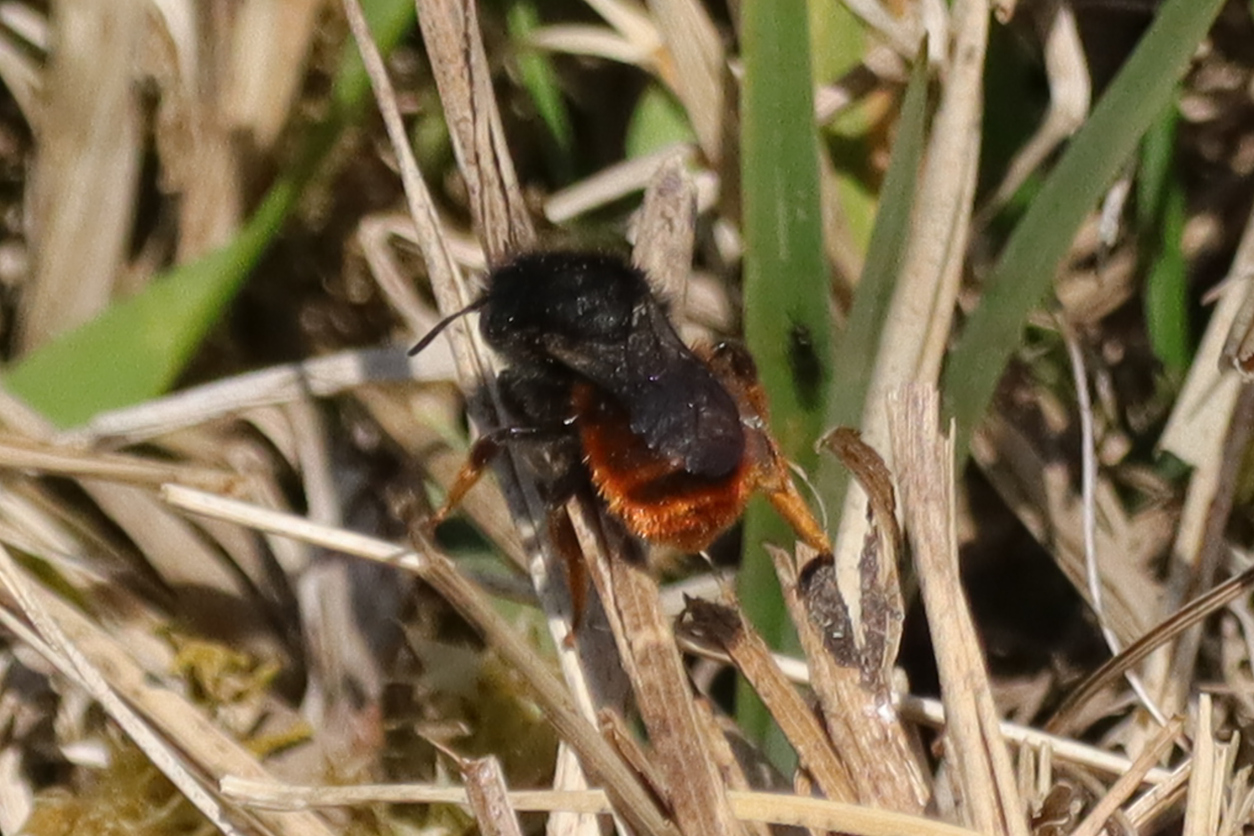
6. Mason Bee
The mason bee (Osmia) is prized for its pollination rate, which is higher than most other bees. Unlike many bees who are social creatures, mason bees are solitary—the female constructs tube-like nests out of mud where she lays eggs and acts as both her own queen and a worker bee. Rather than collecting pollen on their legs, mason bees collect it on all parts of their bodies, and then the pollen transfers to other blossoms when they land. The mason bee is highly desirable in orchards and near commercial fruit and vegetable growers. Beekeepers can keep them in a unique mason bee house with dozens of tubes that attract the female bee. With at least 139 species of mason bees, their sizes vary, but they often resemble carpenter bees with shiny metallic black and blue bodies. Perhaps best of all, the mason bee won’t sting unless it’s squeezed, so there’s relatively no danger to those who work alongside the bees in the garden.
Key Characteristics: This bee lives up to its name as the female constructs tubular nests made from mud to lay her eggs. Both male and female mason bees are black and sometimes blue with an iridescent shine, and they’re always on the go, seeking out new blossoms.
RELATED: 3 Surprisingly Good Reasons to Let Dandelions Grow in Your Yard
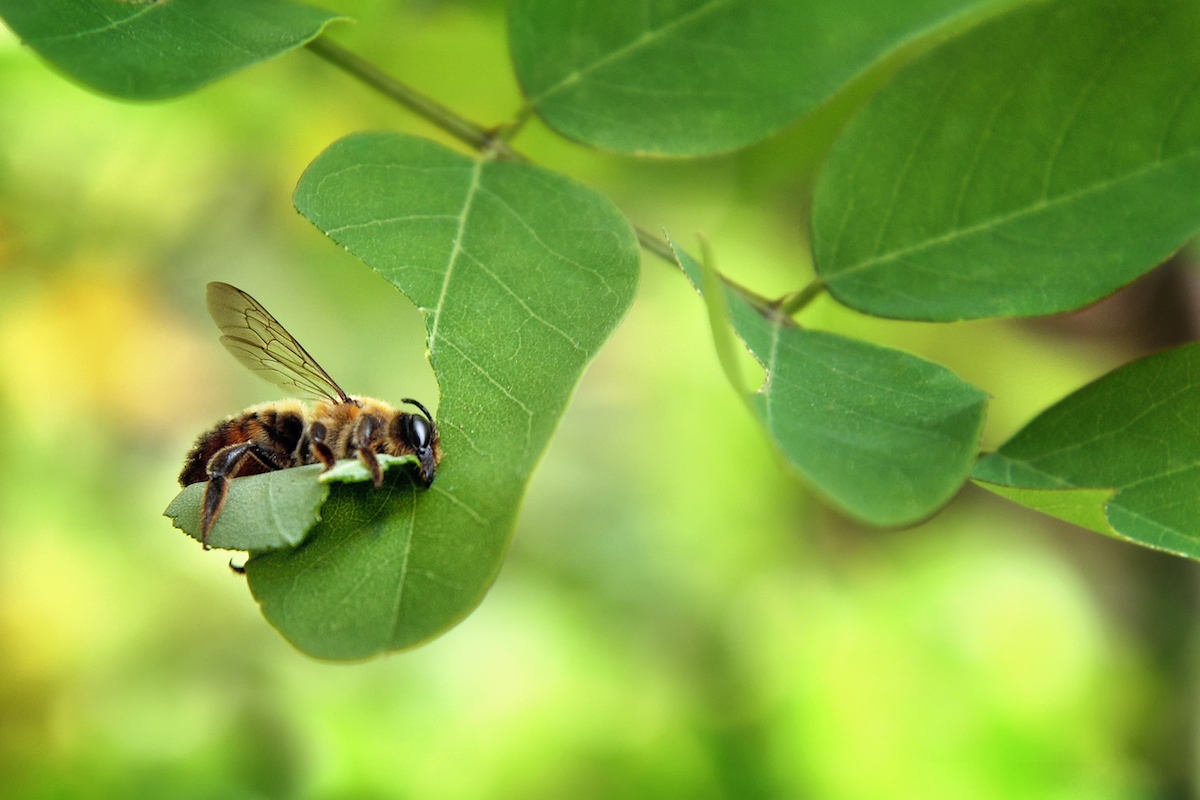
7. Leafcutter Bee
Members of a large bee family with around 242 species, leafcutter bees (Megachilidae) are on the small side, with some measuring as little as ⅕ inch long. They resemble a honeybee with tan/golden coloring and black stripes, but they have larger heads and jaws, which they use to chew out small sections of leaves and take them back to line their nests, which are typically holes in dead trees or rotted wood. Leafcutter bees are excellent pollinators and they gather pollen on their fuzzy tummies rather than legs. They don’t sting unless threatened, and when they do, their sting is much milder than that of a honeybee. After mating, the female leafcutter bee builds her own nest, lays eggs, and feeds her offspring with pollen and nectar.
Key Characteristics: The leafcutter bee resembles a honeybee but with a larger head and jaw area, which is necessary for chewing away the bits of leaves used to build their nests. Unless provoked, the leafcutter bee won’t sting.
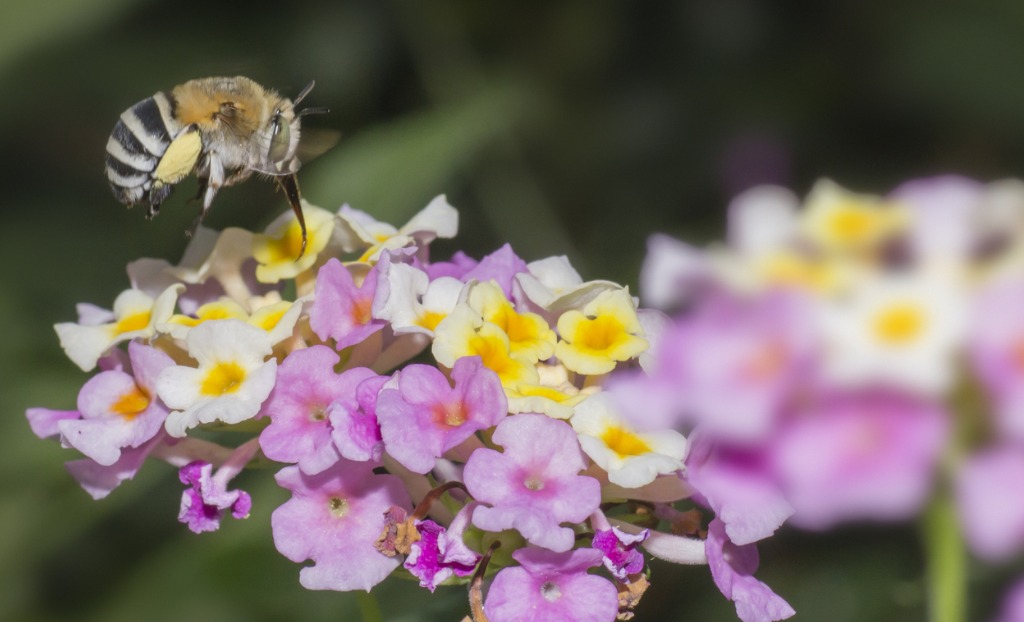
8. Blueberry Bee
While this beneficial pollinator will gather pollen and nectar from various spring-blooming flowers, the bee is highly attracted to rabbiteye blueberries. And, it’s a good thing because this specific type of native blueberry, which grows mainly in the southeastern region of the United States, requires buzz pollination, a particular type of pollination by an insect that vibrates. The blueberry bee (Habropoda laboriosa) is considered the most efficient pollinator of rabbiteye blueberries, although a few other types of bees also can perform buzz pollination. Blueberry bees look like small bumblebees, with a short round body and a large head. The bee’s underside and its lower half are dark brown, while the upper portion of its head is a fuzzy golden color. Like other solitary bees, the blueberry bee does not nest in colonies. The female builds her own nest in the ground—near the nests of other female blueberry bees. Like many solitary bees, they do not have colonies to protect, so they won’t sting unless they are crushed or squeezed.
Key Characteristics: The blueberry bee resembles a small bumblebee with a dark brown and yellow fuzzy body. If you want to see a blueberry bee, look for them in early spring—that’s the only time they’re out. They’re most likely to be found pollinating rabbiteye blueberry bushes or trumpet flowers.
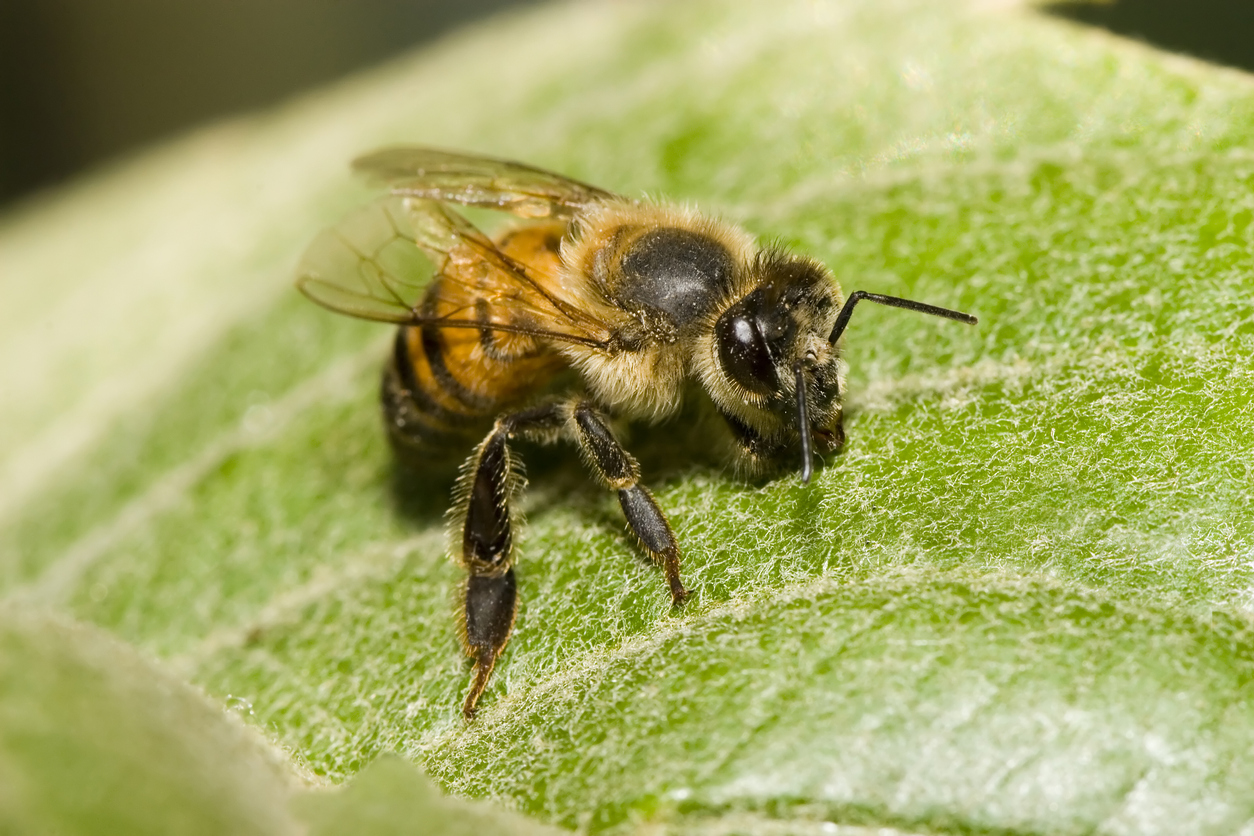
9. Africanized Bee
A highly defensive bee, the Africanized bee (A.m. scutellata), sometimes called “killer bee,” is a cross of the western honeybee and the east African lowland honeybee. While the average honeybee is territorial and will protect its colony, the Africanized bee (not “African” bee) is much more aggressive and will attack human beings. Africanized bees have killed more than 1,000 people. This aggressive bee was released in Brazil in the 1950s and has gradually been migrating north—it can now be found in the southern United States. While this bee does contribute to pollination, it is considered an invasive species, and it is not a desirable pollinator to have around. This bee is often difficult to identify by sight; it looks just like the European honeybee but is slightly smaller. One sign you may be looking at an Africanized bee is its behavior; after it becomes excited, it will continue to show aggression for as long as half an hour. The sting of the Africanized bee is not more painful than that of a regular honeybee, but Africanized bees travel and sting in large swarms, so a victim might receive a lethal dose of venom.
Key Characteristics: To identify an Africanized bee, pay special attention to its behavior. While it looks nearly identical to a European honeybee, it’s more aggressive, more likely to sting without provocation, and it is likely to be traveling with a large swarm of other Africanized bees.
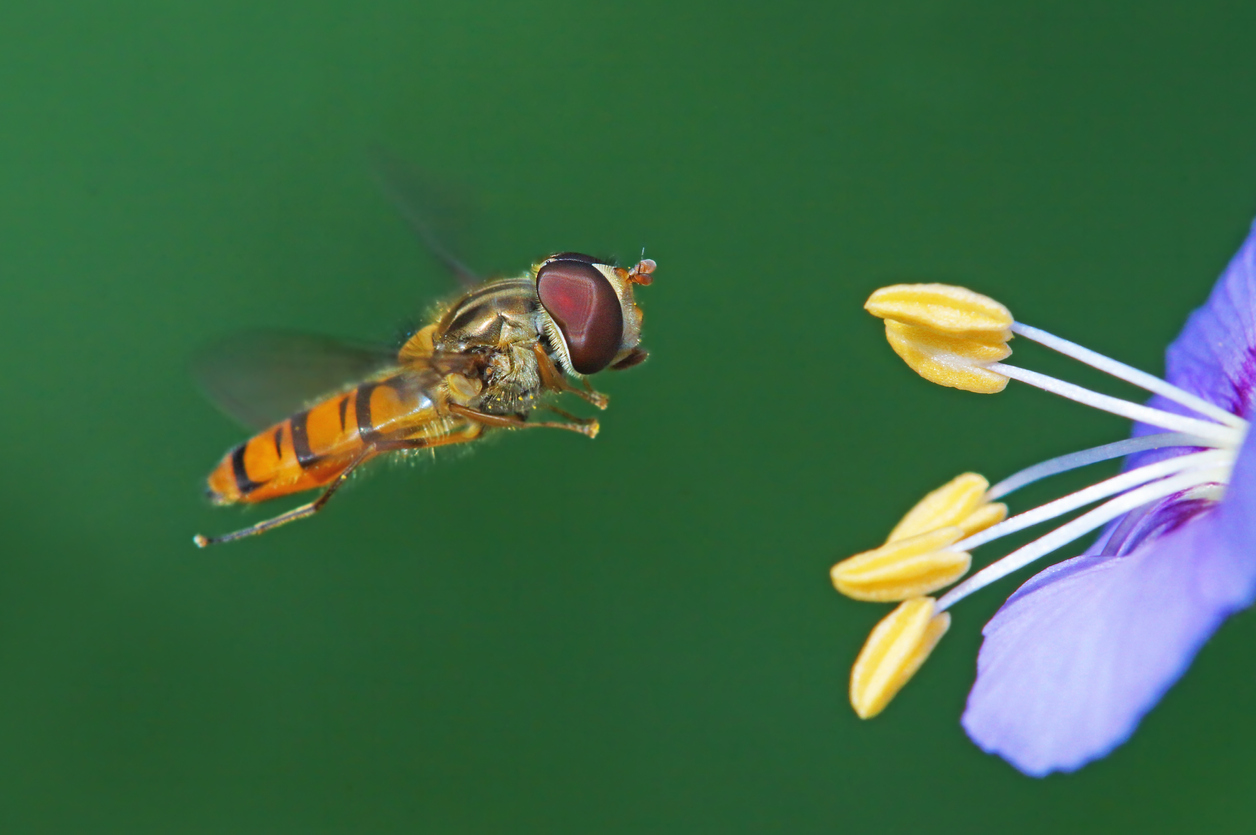
10. Hoverfly
Though they resemble bees or wasps, the hoverfly (Syrphidae) doesn’t sting or bite. It ranges in size from small and slender to as large as a bumblebee, and it sports a black and yellow striped body. Also called a “flower fly,” the hoverfly acts like a honeybee and is known to eat pollen, making it beneficial as a pollinator. The telltale difference is its head, which is identical to that of a housefly. In addition, hoverflies—like all flies—have only one set of wings, while bees have two sets. Rather than nesting as bees do, the hoverfly simply deposits eggs on water or damp wood surfaces, and when the larvae hatch, they begin feeding on aphids or invading ant nests to find food stores. Adult hoverflies also feed on aphids, making them a natural source of aphid control in the commercial rose-growing industry. About 6,000 species of hoverflies exist, which accounts for a wide range in sizes.
Key Characteristics: Looking very much like a honeybee or bumblebee at first glance, the hoverfly has a yellow and black body like a bee, but a head like a housefly. In addition, this colorful fly has only one pair of wings.

